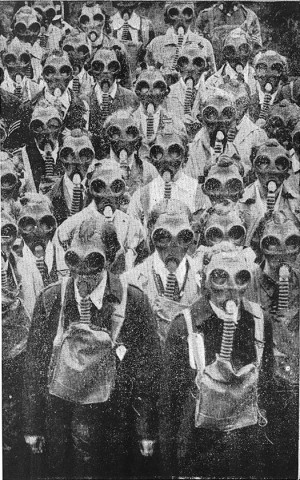Flight reported on 16 March 1912 that ‘A “Mystery” Aeroplane’ was recently seen flying over Warmley, near Bristol:
MANY of the residents of Warmley were considerably excited, says a local paper, at the imposing spectacle of a splendidly illuminated aeroplane passing over the village at a tremendous rate. Certain other people at Bristol and neighbouring places apparently saw the same spectacle, but their version of the story is that a brilliant meteor passed over the district. Aeroplanes are getting to be very speedy birds nowadays, but speeds enough to render machines incandescent have not yet been realised. Will some kind pilot go down to Warmley and show the inhabitants what an aeroplane is really like?
The Observatory, an astronomical journal, reported the same sighting in similarly sarcastic terms:
[…] witness the following account of a large triple-headed fireball, visible on March 6 at 8h 5m, which passed over Ireland, ending in the Irish Sea near the Isle of Man. I am indebted to Mr. Denning for the following newspaper extract:–
Excitement was caused among residents of Warmley on Wednesday evening at the imposing spectacle of a splendidly-illuminated aeroplane rate, and came from the direction of Bath and went on towards Gloucester.
Tremendous indeed! But we are prepared for anything now-a-days.
Unfortunately I haven’t been able to find the newspaper account apparently used by both Flight and the Observatory (quite possibly the Bristol Western Daily News, which the BNA has but not for 1912). At least the Observatory provides a date, 6 March 1912, and, if its identification is accepted, a time about two hours after sunset so quite dark (‘8h 5m’ would be 8.05pm; before 1 January 1925 astronomers began their days at noon rather than midnight).
It does sound like a meteor; aeroplanes in 1912 were not usually splendidly-illuminated nor did they often fly at night — well, not at Warmley; at Hendon it was different. At first blush a meteor over Ireland seems like an unlikely match for one over Somerset and Gloucestershire, but they were heading in roughly the right direction, that is southish to northish, and meteors can easily be seen for long distances.
Why did the people of Warmley think it was an aeroplane, and what meaning did they attach to it? There’s no way to tell from this evidence. Other people in the area (and presumably in Ireland) thought it was a meteor, so it seems like there was no widespread misperception going on. It could just have been a local thing; maybe one person thought it was an aeroplane for some reason and convinced others that it was. Or maybe the newspaper gave an exaggerated impression of opinion at Warmley.
Jump forward twenty-two years. On 6 February 1934, Sir William Davison, Conservative MP representing Kensington South, rose in the House of Commons to ask
the Under-Secretary of State for Air whether his attention has been called to the flight over the City and Central London for nearly two hours on Thursday evening [1 February 1934] of a large aeroplane with heavy-droning engines, as to which neither the Air Ministry or any of the civil aerodromes round London have any knowledge; and whether foreign aeroplanes are permitted to cruise for several hours over London at night without having previously obtained a permit?
To which the Under-Secretary of State for Air, Sir Philip Sassoon, replied:
The aircraft to which my hon. Friend evidently refers was a Royal Air Force aircraft carrying out training exercise, during the evening, in co-operation with ground forces. Such training flights are arranged in the Royal Air Force commands without reference to the Air Ministry.
So this mystery aeroplane, at least, was an actual aeroplane. What was Davison concerned about? Possibly the noise of the ‘heavy-droning engines’; but it seems more likely it was the freedom with which foreign aircraft could apparently fly over London. A couple of weeks later he asked a more general question on this point:
whether foreign commercial or privately-owned foreign aeroplanes are allowed to cruise over London and other large cities, not on any regular air route, at night without a permit; and what, if any, regulations in this respect obtain with regard to foreign cities?
He probably wasn’t very reassured by Sassoon’s answer on this occasion:
No permits would be necessary in the case of civil aircraft of States that are parties to the international Air Convention or of certain other States with which special air agreements are in operation. This is subject, of course, to compliance with the regulations as to safety provisions and navigation lights, and to the avoidance of any prohibited areas. The position as regards flights over foreign towns is reciprocal.
Davison had crossed swords with Sassoon at the end of January on the question of the disparity between British and French airpower (a theme he had also raised in 1925, though it doesn’t seem like he did participate in debates about aviation all that often). So that seems likely to be the context of his concern: the French menace (1210 first-line aircraft in France to 420 in Britain!)
The other question, though, is what did others make of the mystery aeroplane? From Davison’s question it sounds like somebody did some investigation, ringing around aerodromes and the Air Ministry to find out where it came from, which sounds like a job for a journalist. But I haven’t been able to find any press reports so that’s only a guess. And unfortunately that also means I can’t tell if Davison’s interpretation was idiosyncratic or symptomatic.
![]() This work is licensed under a Creative Commons Attribution-NonCommercial-NoDerivatives 4.0 International License.
Permissions beyond the scope of this license may be available at http://airminded.org/copyright/.
This work is licensed under a Creative Commons Attribution-NonCommercial-NoDerivatives 4.0 International License.
Permissions beyond the scope of this license may be available at http://airminded.org/copyright/.




